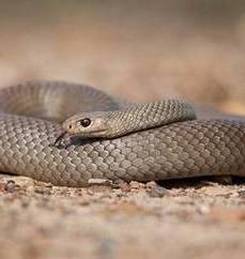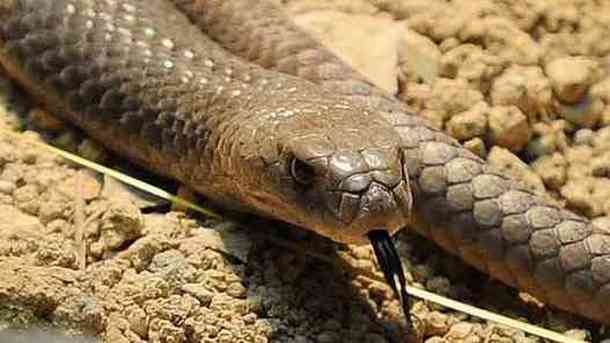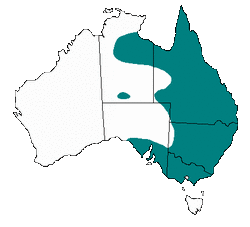Eastern Brown SnakePseudonaja textilis |

Custom Search
|
|
The Eastern Brown (Pseudonaja textilis), also known as the Common brown snake is a venomous elapid snake found in the eastern half of Australia, except in Tasmania. There are no subspecies recognized.
The species is also found in the Eastern Papua New Guinea but only in very limited numbers. Based on its LD50 value (subcutaneous) it's considered the world's second most venomous land snake, just after the inland taipan. The Eastern Brown is found in many types of habitats from Eucalypt forests, pastures, coastal heathlands, savannah woodlands, arid shrublands and inner grasslands. They have also adapted to semi-urban, farmed and grazed environments. These snakes are diurnal, meaning they most active during the day, especially on warm sunny days, making them probably the most frequently encountered venomous snake in Australia. These are agile and fast-moving snakes, hunting by day and returning to its burrow at night. During the winter with colder temperatures they remain in their burrows for a period of 4 or 5 months. They are usually orange or brown in color, but there are many variations in color ranging from lighter to darker brown to almost black. The belly is usually a light cream, yellow or orange, and often speckled with orange or dark grey blotches.
The eastern brown snake has an average length between 3.6 to 5.9 feet (1.1 to 1.8 m). Any snake measuring more than 6.6 ft (2 m) is considered exceptionally large, but the maximum recorded length for the species is 7.9 ft (2.4 m). They have a slender body, with a short and rounded head, indistinct from the neck. In this species the males grow larger than females.
The Eastern Brown predators include birds of prey and feral cats, and the appear to have immunity to the venom of the Mulga Snake (Pseudechis australis) a possible predator. However like many other australian species they aren't so immune to the poison of the introduced cane toad and quickly die from ingesting them. The Eastern Brown life span in wild is unknown, but in captivity they lived for as long as 7 to 10 years. Venom / Bite
The eastern brown is considered the 2nd most venomous snake in the world, surpassed only by the inland taipan (Oxyuranus microlepidotus). But contrary to the inland taipan, the Eastern Brown's habitat includes some of the most populated parts of Australia, which puts them in contact with humans more often. In comparison to some other snake species such as cobras and vipers, the Eastern Brown has very short fangs, only about 3mm in length. Even though they may bite several times if provoked, they inject only a very small amount of venom, about 4 mg, but this is more than enough to kill a human. Their venom has a subcutaneous LD50 range of 36.5 to 53 μg/kg consisting for the most part of neurotoxins and blood coagulants.The symptoms include collapse, convulsions, diarrhea, dizziness, renal failure, paralysis and cardiac arrest, and without proper medical treatment, bites can prove fatal. For this reason they are responsible for most deaths caused by snake bites in Australia, but with efficient first-aid treatment and antivenom, there are now usually only 1 or 2 deaths per year. Diet / Feeding The eastern brown feeds mainly on small mammals, in particular rodents, the introduced rats and mice and because of this it's often found around farm buildings. But they also feed on frogs, lizards, birds, eggs and they even feed on other snakes. Younger and smaller snakes eat more ectothermic prey, such as lizards, while the larger ones mainly consume warm-blooded prey. Reproduction The Eastern Brown breeding season begins in mid to late spring. The males will engage in a form of ritual combat to gain the right to mate with receptive females. They will intertwine tightly with each male trying to push down and overpower the other, these "fights" may last for an hour or more. The species is oviparous and females lay up to 25 eggs in late spring or early summer, but the average clutch is about 15 eggs. The hatchlings size at birth varies both within and among clutches, ranging from 7,5 to 11 inches, and they are totally independent from the mother. The sexual maturity in this species may be reached in just 2,5 or 3 years. Conservation / Threats Just like all other Australian snake species, the Eastern Brown is protected by law, so killing or capturing is prohibited. Since the Eastern Brown Snake is a very adaptable species. It's capable of inhabit areas occupied by human activity and also consumes an abundant, exotic food source, the introduced rats and mice, so the species future conservation seems assured. Even so many Eastern Brown snakes fall victim to road kill every year and many others are killed on sight by farmers and landowners. Despite their reputation they perform a very useful role for farmers by controlling the population of introduced rodent pests.
|
Did You Know?
Found in South America the green anaconda is, considered the largest snake in the world. Scientific classification |
© 2014 Snake Facts About Us | Privacy Policy | Contact





